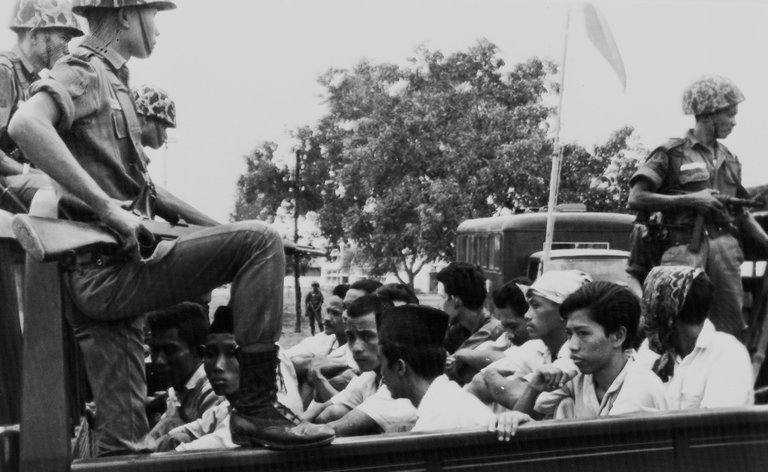Review: The Jakarta Method
The liberal Western narrative of the Cold War is that a flawed but well intentioned democracy (the United States) prevailed against a tyrannical regime that sought to spread its ideology throughout the world (the Soviet Union). The rest of the world is assigned bit parts in tales of proxy wars and covert ops between the superpowers.
In The Jakarta Method, journalist Vincent Bevins reveals a much darker story of the Cold War, one in which Third World nations sought independence from colonial rule and from post-colonial imperial domination by any superpower, and in which the United States and its allies countered such efforts, in part, through an international program of mass murder.
As the book’s title suggests, this history is centered on events in Indonesia, which is the 4th most populous nation on Earth today. After achieving its independence from the Dutch (whose colonial rule had left the country with a literacy rate of less than 10%), the new country’s first president, Sukarno, sought to build alliances with other Third World nations and organized the historic Bandung Conference in 1955.
A template for mass murder
Sukarno was not a communist, but he tolerated the Communist Party as one of multiple constituencies he unified under his increasingly authoritarian rule. The United States grew impatient with Sukarno’s anti-imperialism, and supported staunchly anti-communist military men who could replace him.
Eventually, one such man, Suharto, used the chaos of a failed coup attempt by other members of the military (of which he had foreknowledge) as a pretext to take power. He blamed the communists and implemented a mass murder program that killed a vast number of human beings, with estimates ranging from 500,000 victims on the low end to 2-3 million on the high end.

Alleged young communists detained by Indonesian troops in October 1965. (Credit: Associated Press. Fair use.)
The US did not simply tolerate this campaign; it provided training and support to anti-communists in the Indonesian military, and even supplied kill lists which were used to hunt down and murder thousands, as the Washington Post reported in 1990:
For the first time, the officials are acknowledging that they systematically compiled comprehensive lists of communist operatives, from the top echelons down to village cadres in Indonesia, the world’s fifth most populous nation. As many as 5,000 names were furnished over a period of months to the army there, and the Americans later checked off the names of those who had been killed or captured, according to the former U.S. officials.
Unlike other atrocities of the 20th century, this one remains little-known in the Western world, for obvious reasons: history is written by those who prevailed. As Bevins shows, the slaughter became a template for mass murder programs elsewhere, including in Latin America.
Before those programs began under authoritarian regimes in countries like Chile, Argentina, and Brazil, the word “Jakarta” itself was employed as a threat. Leftists and fanatical anti-communists alike knew all too well what it meant: mass murder at an unimaginable scale. Suharto had made Indonesia’s capital synonymous not with Third World emancipation, but with exterminating the political left.
Making the world safe for capitalism
The narrative of anti-communism is that all movements calling themselves socialist or communist ultimately become tyrannical, justifying the absolutist stance that the United States took in the Cold War. But the US supported murderous regimes like Suharto’s, while forcefully opposing emancipatory politics by Third World countries—no matter how democratic.
By replicating the Jakarta method around the world, the US and its allies destroyed the possibility of a moderate, democratic path to political and economic emancipation for Third World countries. The “friendly dictators” installed to exterminate the left frequently brought ruin for the rest of society, as well. Besides slaughtering hundreds of thousands, if not millions, of his own people, Indonesia’s Suharto embezzled up to $35 billion; in 2004, Transparency International ranked him as the world’s most self-enriching leader of the previous two decades.
The Jakarta Method is not a defense of communism as it existed in the 20th century. Bevins promotes no ideology and refrains from hyperbole or polemic; he simply recounts the facts, supported by the personal stories of survivors from around the world. If anything, given the secrecy of the programs Bevins writes about, many chapters in this dark history likely are yet to be illuminated.
The book reveals that the Cold War cannot be understood without the stories of the millions of people who fought for a better tomorrow, and whose lives were brutally extinguished to bequeath us the world we live in today. Not because of a choice between a greater and a lesser evil, as the liberal Cold War narrative would have us believe, but because of actions which were unspeakably evil in their own right.
